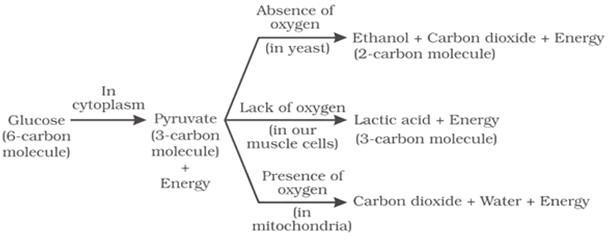CBSE
Class 10 Class 12
The process by which a living being utilizes the food to get energy is called respiration. Respiration is an oxidation reaction in which carbohydrate is oxidized to produce energy. The mitochondrion is the site of respiration and the energy released is stored in the form of ATP (Adenosine triphosphate). ATP is stored in mitochondria and is released as per need.
STEPS OF RESPIRATION:
Breaking down glucose into pyruvate: This step happens in the cytoplasm. A glucose molecule is broken down into pyruvic acid. A glucose molecule is composed of 6 carbon atoms, while pyruvic acid is composed of 3 carbon atoms.
The fate of Pyruvic Acid: Further breaking down of pyruvic acid takes place in mitochondria and the molecules formed depend on the type of respiration in a particular organism. Respiration is of two types, viz. aerobic respiration and anaerobic respiration.

TYPES OF RESPIRATION:
Aerobic Respiration: This type of respiration happens in the presence of oxygen. Pyruvic acid is converted into carbon dioxide. Energy is released and a water molecule is also formed at the end of this process.
Anaerobic Respiration: This type of respiration happens in the absence of oxygen. Pyruvic acid is either converted into ethyl alcohol or lactic acid. Ethyl alcohol is usually formed in case of anaerobic respiration in microbes; like yeast or bacteria. Lactic acid is formed in some microbes as well as in the muscle cells.